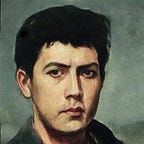Individual Map
I. Every individual is a circle.
II. A circle connected with a line is every individual in geometric shape, depicted in space for that very shape.
III. Circles are individuals, lines are links to circles other than the circle of the individual-self, which to other individuals.
IV. A circle to other circle connected by a line forming the individual map.
V. Every circle connected to circles other than its circle form an individual map by its stance as the individual self.
VI. Individual map can be formed reciprocally or not reciprocally for its unitary relation.
VII. The word self only serves an individual point of view for every individual map with its unitary relation with other individuals, which is other individual maps other than the self-individual map. The geometric shapes of circles and lines stand the same.
VIII. Every individual map has a range of unitary relations formed started from the self-individual map to other individual maps.
IX. Every individual map has an indefinite range of unitary relations, which makes the range different. The difference comes from the individual ability to think and portray the range of unitary relation of the self-individual map with other individual maps.
X. Every individual knows only a finite understanding and perception of the self-individual map range of unitary relation with other individual maps, let alone to think and portray other individual maps range of unitary relation with other individual maps.
XI. The range of unitary relation of individual maps cannot be precisely known in which formed by such free will or determined.
XII. Free will and determination are not seen as choices for the point of discussion, but the way to think and portray the range of unitary relation of individual maps as differently for every individual map. Different range, quantity, and how the unitary relation formed.
XIII. The term choices does not explain anything other than an uncertain choice between free will or determination. Choices in the non-choice concept of determination, and to choose is in the concept of free will, is a contradiction. Choices in a free will which free will and determined is not precisely known as free or determined will — then the term choices, which exists on the choice between free and determined will, is a contradiction. If choices do not exist at all, and it is necessary to decide between free will or determination, it goes back to not knowing exactly between free will or determination, which gives rise to the term choices.
XIV. The expansion of the range of unitary relations of every individual map begins with each individual map in the world. Unitary relations have a range that is not constant for every individual map. These connected circles of every individual map are as if they were connected and disconnected. It is the lines of the circles that actively extend and diminish the range for the circle that remains in a static position.
XV. The expansion of the unity relation of every individual map in the world cannot ever end unless every individual map does not have unitary relation with any individual maps other than the self-individual map. To end and disappear is not possible even by the concept of death. Death cannot be the case for the ending, the disappearance, the non-existence of the individual map, and the unitary relation of in the world.
XVI. The inconstancy of the range of unitary relations of every individual map is affected by the concepts of death, confusion, and oblivion — but not for the ending. Disappearance is not constant, for every individual map can reconnect to other individual maps and begin the expansion of the range using the concept of memory, or recollection.
XVII. Every concept stated is the ability of every individual, which is constantly changing, and so those concepts struggle in opposition, which affects the range of unitary relationships of every individual map in the world.
XVIII. All concepts presented are not constant, except the concept of nothingness, or the state before individual maps and the space that contains it. The effect of the concepts of death, confusion, and oblivion is not equivalent to the concept of nothingness.
XIX. The ability of every individual map to conceptualize makes nothingness impossible. The world is a space and remains constituted as opposition, even if every individual map and the range of unitary relation has disappeared. Nothingness is the case if it is as it is, constant, and impossible is not constant. Nothing could be equivalent to nothingness.
XX. All concepts that have been presented do not change the individual map geometric shape, and in the world as in space that contains it. The picture, the shapes and the space, the world, and every individual map are visible and the same, the pictures of and by every individual map and the range of unitary relations.
XXI. Every individual can only perceive a finite range of the unitary relation of the self-individual map or other individual maps, but never the entirety of the stated.
XXII. Every individual map with the range of unitary relation that constantly changing affects the picture. But the picture for every individual is not precisely known to be the case, or not the case, as the picture also constantly changing of the concepts stated in (XVI). The picture is every individual ability to conceptualize a non-literal to a literal of a picture, and these two will never be in accordance.
XXIII. The picture of the world as in space is not affected by anything stated. Nothing more than to follow the inconstancy of the range of unitary relation of every individual map, as the space that contains it.
To be continued…
